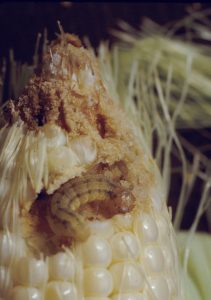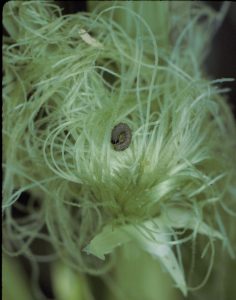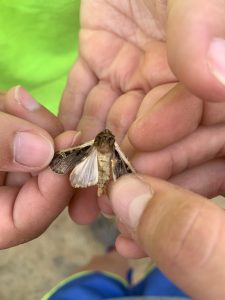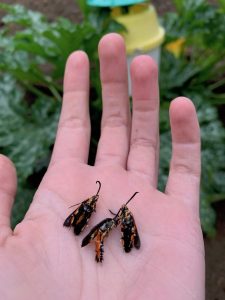Sweet Corn IPM Newsletter No. 6 – August 16, 2019
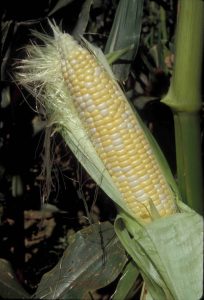
Sweet Corn IPM Newsletter No. 6 – August 16, 2019
Click on photos to enlarge.
CORN EARWORM PRESSURE HIGHEST OF THE SEASON
All Sites Now Need Protection on Silking Corn
SITUATION
Corn harvest is coming into full swing, with warm temperatures hastening maturity of later planted fields. Corn earworm moth counts continued to climb this week, keeping all silking fields on a tight spray schedule. Fall armyworm and western bean cutworm moth counts also continue to be high. Reports of bird and animal damage to developing ears are starting to come in, so growers should be checking fields for injury.
European corn borer: No feeding injury was over the 15% control threshold on pre-silking corn this week, and only a few moths were caught in traps. There is the possibility of a second generation of corn borer emerging to threaten late corn, but we have seen no indication yet, based on the very low moth captures in recent days.
- Corn Earworm Larvae; photo by David Handley
- Fall Armyworm on Corn Silk; photo by David Handley
- Western Bean Cutworm Moth; photo by Lindsey Ridlon
Corn earworm: Moth captures increased at most locations this week, so earworm remains the most significant threat silking corn. A six-day spray interval for silking corn was recommended in Garland this week. A five-day spray interval was recommended for silking fields in Farmington, Palmyra and one Wells site. A four-day spray schedule was recommended in Auburn, Biddeford, Bowdoinham, one Cape Elizabeth site, Charleston, Dayton, Lewiston, Levant, Monmouth, New Gloucester, Nobleboro, North Berwick, Poland Spring, Sabattus, Wayne and one Wells site. A three-day spray interval was recommended at one Cape Elizabeth site.
Fall armyworm: Moth counts were over the 3-moth threshold for silking corn in Bowdoinham, Cape Elizabeth, Dayton, Lewiston, New Gloucester, Monmouth, Poland Spring, and Wells; but all sites were also under a spray interval for corn earworm, so no additional controls should be needed. Larval feeding damage was not over the 15% spray threshold in any of our locations this week.
Western bean cutworm: Moth counts remain high at all trapping locations this week, exceeding the suggested three moth per week threshold for silking corn. Sprays applied to silking corn for corn earworm should also protect against western bean cutworm.
- Rust on Corn; photo by David Handley
- Aphids on Corn Tassel; photo by Kaytlin Woodman
- Three Squash Vine Borer Moths; photo by Lindsey Ridlon
Corn leaf aphids: These small, soft-bodied insects often infest corn plants later in the season, especially in fields that have not recently been sprayed for other pests. Colonies of bluish-green aphids can cover tassels, stalks and husks. Their waste encourages the growth of the sooty mold fungus, which can cover the husks. Sprays for corn earworm will usually control aphids.
Corn rust: Rust is a fungus disease, which appears as reddish-brown pustules on corn leaves and husks, reducing the quality of the ears. A fungicide spray for rust is only recommended when the symptoms are seen prior to tasseling. Later infections are unlikely to cause enough damage to warrant control measures. Materials available to control corn rust include Quadris®, Bravo®, and Quilt®.
Squash vine borer: Moth counts were lower at all locations this week. No fields were above the spray threshold of 5.
Sincerely,
David T. Handley
Vegetable and Small Fruit Specialist
Highmoor Farm UMaine Extension Diagnostic
P.O. Box 179 Research Lab, Pest Mgmt. Unit
52 U.S. Route 202 17 Godfrey Drive
Monmouth, ME 04259 Orono, ME 04473
207.933.2100 1.800.287.0279
Sweet Corn IPM Weekly Scouting Summary
| Location | CEW Moths |
ECB Moths |
FAW Moths |
WBC Moths |
Feeding Damage |
Recommendations / Comments |
|---|---|---|---|---|---|---|
| Auburn | 78 | 0 | 2 | 43 | 4-day spray interval for all silking corn | |
| Biddeford | 50 | 0 | 2 | 8 | 12% | 4-day spray interval for silking corn |
| Bowdoinham | 37 | 0 | 4 | 4 | 3% | 4-day spray interval for all silking corn |
| Cape Elizabeth I | 69 | 0 | 18 | 20 | 8% | 4-day spray interval for silking corn |
| Cape Elizabeth II | 137 | 0 | 5 | 39 | 3-day spray interval for silking corn | |
| Charleston | 21 | 1 | 1 | 4-day spray interval for all silking corn | ||
| Dayton I | 69 | 1 | 2 | 30 | 0% | 4-day spray interval for silking corn |
| Dayton II | 85 | 1 | 15 | 38 | 0% | 4-day spray interval for silking corn |
| Farmington | 4 | 0 | 0 | 38 | 5-day spray interval for silking corn, | |
| Garland | 3 | 0 | 0 | 6-day spray interval for all silking corn | ||
| Lewiston | 39 | 0 | 5 | 41 | 4-day spray interval for all silking corn | |
| Levant | 10 | 0 | 0 | 4-day spray interval for all silking corn | ||
| Monmouth | 17 | 0 | 6 | 67 | 4% | 4-day spray interval for all silking corn |
| New Gloucester | 66 | 0 | 45 | 61 | 5% | 4-day spray interval for silking corn, |
| Nobleboro | 31 | 0 | 1 | 8 | 0% | 4-day spray interval for all silking corn |
| No. Berwick | 41 | 0 | 2 | 4 | 0% | 4-day spray interval for all silking corn |
| Palmyra | 6 | 0 | 0 | 1% | 5-day spray interval for all silking corn | |
| Poland Spring | 9 | 0 | 5 | 90 | 1% | 4-day spray interval for all silking corn |
| Sabattus | 8 | 2 | 0 | 9 | 4-day spray interval for all silking corn | |
| Wayne | 12 | 0 | 0 | 12 | 13% | 4-day spray interval for all silking corn |
| Wells I | 7 | 0 | 0 | 4 | 5-day spray interval for all silking corn | |
| Wells II | 52 | 0 | 10 | 10 | 8% | 4-day spray interval for all silking corn |
CEW: Corn earworm (Only fresh silking corn should be sprayed for this insect.)
ECB: European corn borer
FAW: Fall armyworm
WBC: Western bean cutworm
Corn Earworm Spray Thresholds for Pheromone Traps
| Moths caught per week | Moths caught per night | Spray interval |
|---|---|---|
| 0.0 to 1.4 | 0.0 to 0.2 | No spray |
| 1.5 to 3.5 | 0.3 to 0.5 | Spray every 6 days |
| 3.6 to 7.0 | 0.6 to 1.0 | Spray every 5 days |
| 7.1 to 91 | 1.1 to 13.0 | Spray every 4 days |
| More than 91 | More than 13 | Spray every 3 days |
Thresholds apply only to corn with exposed fresh silk. Lengthen spray intervals by one day if maximum daily temperature is less than 80°F.
European Corn Borer Thresholds
Whorl stage: 30% or more of plants scouted show injury.
Pre-tassel-silk: 15% or more of plants scouted show injury.
Silk: 5 or more moths caught in pheromone traps in one week.
IPM Web Pages:
UMaine Cooperative Extension Integrated Pest Management
Penn State Pest Watch – Sweet Corn
UMass Amherst Integrated Pest Management
Where brand names or company names are used, it is for the reader’s information. No endorsement is implied nor is any discrimination intended against other products with similar ingredients. Always consult product labels for rates, application instructions and safety precautions. Users of these products assume all associated risks.
The University of Maine is an equal opportunity/affirmative action institution.

